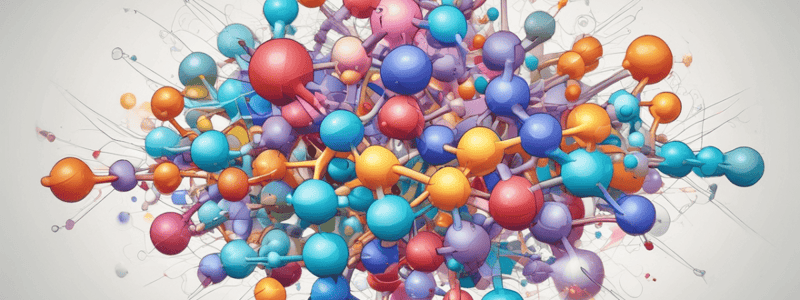Podcast
Questions and Answers
Which of the following statements is true about the peptide bond?
Which of the following statements is true about the peptide bond?
- It is a covalent bond between the R-group of one amino acid and the amino group of another.
- It is a bond between the α-carbon of one amino acid and the carboxyl group of another. (correct)
- It is an ionic bond between the amino group of one amino acid and the carboxyl group of another.
- It is a hydrogen bond between the nitrogen and oxygen atoms of two amino acids.
What is the main function of the R-group in an amino acid?
What is the main function of the R-group in an amino acid?
- It is involved in the denaturation of proteins.
- It is responsible for the formation of the peptide bond.
- It defines the properties and function of the amino acid. (correct)
- It determines the pH of the amino acid.
What is the result of defects in amino acid metabolism?
What is the result of defects in amino acid metabolism?
- Proteins are more readily folded and have a more stable tertiary structure.
- Proteins are more stable and less prone to denaturation.
- Defects in amino acid metabolism may lead to disease. (correct)
- Proteins are more resistant to changes in pH and temperature.
What is the role of the α-carbon in an amino acid?
What is the role of the α-carbon in an amino acid?
What is the state of the amino and carboxyl groups at physiological pH?
What is the state of the amino and carboxyl groups at physiological pH?
What is the number of universal structural amino acids that are encoded in DNA?
What is the number of universal structural amino acids that are encoded in DNA?
What is the role of the peptide bond in protein structure?
What is the role of the peptide bond in protein structure?
What is the result of the nitrogen and oxygen atoms of the peptide bond interacting with other peptide units?
What is the result of the nitrogen and oxygen atoms of the peptide bond interacting with other peptide units?
What is the result of a defective phenylalanine hydroxylase enzyme in Phenylketonuria?
What is the result of a defective phenylalanine hydroxylase enzyme in Phenylketonuria?
What is the function of the partial charges on the peptide bond?
What is the function of the partial charges on the peptide bond?
What is the unique feature of selenocysteine?
What is the unique feature of selenocysteine?
What is the role of hydroxyproline in collagen?
What is the role of hydroxyproline in collagen?
What is the result of a defective tyrosinase enzyme in Albinism?
What is the result of a defective tyrosinase enzyme in Albinism?
What is the purpose of amino acid polymerization?
What is the purpose of amino acid polymerization?
What is the characteristic of the peptide bond?
What is the characteristic of the peptide bond?
What is the function of homocysteine?
What is the function of homocysteine?
Flashcards are hidden until you start studying
Study Notes
Amino Acids
- Amino acids have an amino group and carboxylic group attached to the same carbon (α- carbon)
- There are 20 universal structural amino acids that are encoded in DNA
- Each amino acid has a different R-group attached to the α- carbon, which defines its properties and function
- At physiological pH, the amino and carboxyl group are ionized
Classification of Amino Acids
- Some amino acids are essential for the human diet due to the lack of enzymes to synthesize them de novo
- Other amino acids exist in cells that are not universally encoded in DNA, such as:
- Hydroxyproline: formed by hydroxylation of proline, important component of collagen
- Selenocysteine: contains Se instead of S, reduced pKa useful for enzymes in anti-oxidant activity
- Homocysteine: contains an extra methyl group compared to cysteine, needed to synthesize cysteine
Peptide Bond Formation
- Amino acids polymerize to form polypeptides (proteins) via the formation of the peptide bond between the alpha amino and alpha carboxylic groups of adjacent amino acids
- The formation and hydrolysis of peptide bonds require enzymes
- The peptide bond is very strong and has some features of a double bond:
- It is shorter than the standard C-N bond length
- There is no rotation
- The R-groups are in the trans configuration
- There is a partial negative charge on the oxygen atom and partial positive charge on the nitrogen atom
Importance of Peptide Bond
- The partial charges on the peptide bond are important in the formation of hydrogen bonds that are key for protein structure
- Defects in metabolism result in a number of clinical conditions, such as:
- Phenylketonuria (PKU): defective phenylalanine hydroxylase
- Albinism: defective tyrosinase
Studying That Suits You
Use AI to generate personalized quizzes and flashcards to suit your learning preferences.




